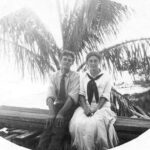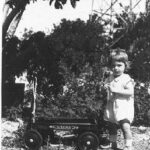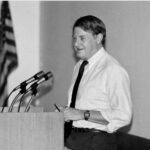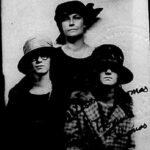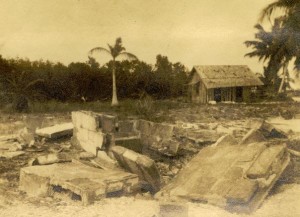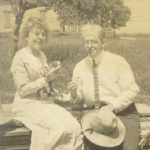Every year about this time, during Halloween, someone shows up at Koreshan to see, or talk about, or experience(?) the paranormal. Are there ghosts at the Park?
I suppose it is all done in good fun, although some take it quite seriously. Others, hopefully most, not so much. Our purpose on this site is to inform others about the Koreshans, the Koreshan Unity and Dr. Teed. Over the years we’ve debunked a few misconceptions. For example the Koreshans themselves promoted the belief that Dr. Teed ws a surgeon during the civil war. This was false. See our post Civil War Doctor which we published in 2010.
Still watching over their legacy
Unearthing the haunted history at Koreshan State Park
EXPLORING THE eerie
October 30, 2024
BY OLIVIA WILD
olivia.wild@floridaweekly.com
Most people don’t think of Estero’s Koreshan State Park as a spooky place, but tales of ghostly encounters have circulated for years—rumors of shadows, whispers and unexplained movements.
Beyond its natural beauty, the park is steeped in a rich history that adds to its mysterious allure. Walking through the park, I couldn’t shake the sense that I was being watched, as if the past lingered in the air around me.
The story of the Koreshan Unity began in 1894 when Cyrus R. Teed—who called himself Koresh—led his followers from Chicago to the swampy lands of Southwest Florida. They made a deal with local landowner Gustave Damkohler for 320 acres, the start of their utopian society called “New Jerusalem.”
Teed believed he was the next prophet and claimed that an angel revealed a “divine illumination” during his alleged electrical experiments on himself and instructed him to “save the race.”
The early 1900s were the glory years for the Koreshans. They cleared the land, erected buildings, cultivated crops and built a self-sustaining community of about 200 people. Their land holdings, not contiguous with the actual settlement, spanned up to 7,500 acres. The developed area had more than 70 buildings and a dozen businesses.
They believed that living a celibate life would lead to immortality, and their focus on gender equality attracted many women, who made up about 80% of the population. Teed also taught that women were in “marital slavery” and encouraged them to leave their husbands and join the commune, promising a life of freedom and higher purpose.
The term “religion-science” was created to encapsulate their alternative beliefs. One of their most notable concepts was “cellular cosmogony” — the theory that we live inside the shell of a hollow Earth, with the sun positioned in the center like a yolk.
Learning this was the scariest part of the tour; I’ve never been so horrified.
Teed’s death on Dec. 22, 1908, marked the beginning of the Unity’s decline. Hoping for his resurrection, followers kept his body in a metal bathtub for five days at his beach house on Estero Island (now Fort Myers Beach). The county health inspector had to intervene and stop the unlawful mourning practice.
Teed was buried in a concrete mausoleum nearby, but his peace was short-lived.
In 1921, a devastating hurricane destroyed the mausoleum, scattering his remains into the sea.
By 1956, only five members remained. The last member, Hedwig Michel, passed away in 1982, closing the chapter on Koreshanity and is buried near the Koreshan Bakery.
On my guided historical tour, I met Ron Westcott, a volunteer, tour guide and retired arborist who’s been involved with the park for 12 years.
Westcott shared his extensive knowledge of the Koreshans’ vision and the challenges they faced.
“It’s a part of history that people don’t understand. We’re stepping back in time to a completely different era where people’s values and aspirations were very, very different from what they are today,” Wescott said.
While he had never personally experienced anything paranormal, Westcott pondered, “Maybe you need to be predisposed to be able to receive that kind of thing?” Then joked, “Apparently, I’m not.”
For many, the draw to Koreshan State Park isn’t a ghost sighting but the chance to connect with history. Ed and Dolores Short, who joined me on the tour, cherished the sense of stepping back in time.
“The fact that these are still here is amazing,” Ed Short said, admiring the preserved buildings that transport visitors back over a century. Dolores Short added, “It gives you a perspective.”
Paranormal investigator Joshua Edilla describes the energy at the park as more “sad” than malevolent. Perhaps it’s the lingering echo of the Koreshans’ losses over time. I sensed an unavoidable feeling of melancholy permeating the walls and felt like there were more people than just the tour walking around.
When Edilla was outside the Founder’s House with his family, he felt a hand grip his shoulder. “I could feel the fingers and the impression that someone was trying to get my attention. My back was towards the building. It would be virtually impossible for someone to touch me that way,” Edilla recounted.
After the tour, I sat inside the Founder’s House and watched a 20-minute documentary, hoping to feel something, but sadly, nothing caught my attention.
Edilla, host of The Animal Paranormal Podcast Show, explores mysteries on land and underwater. His podcast is on platforms like Amazon Music, iHeartRadio, Podbean, Spotify and YouTube. New episodes are released every Saturday at 8 p.m.
“I usually go on investigations at least three times a month. Unless I get an emergency investigation where there is a haunting that is bothering people,” Edilla said.
Edilla recommends using minimal equipment, such as relying on your senses and using a simple voice recorder. This approach could make spirits more receptive and open to interaction, as it involves fewer possessions and distractions. “You want to keep your eyes and ears open,” he advised.
Maybe that’s why I didn’t capture anything paranormal. With my DSLR camera and phone in hand, the spirits might have been put off by the extra equipment. But that just gives me an excuse to return, right?
